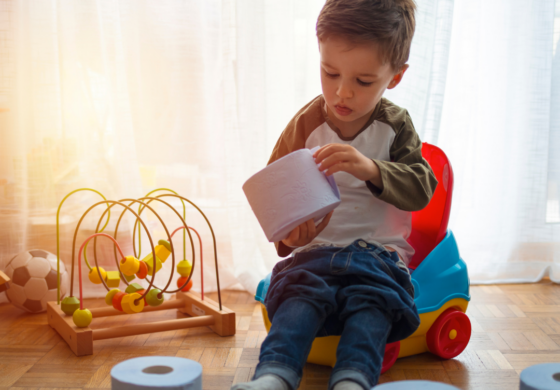“We’ve got the pee down but the poop just won’t come.” Does this sound familiar? I very often hear parents tell me that their child has the peeing down quickly but they’re struggling with pooping difficulties. There are several possibilities that could explain this all-too-frustrating challenge.
Potty Training Is All About The Poop And Not About The Pee
Toddlers on average pee up to 11 times a day.
If you’re sitting them on the potty every hour, chances are you’re going to catch them at just the right time and their bladder will empty into the toilet with little to no effort on their part. This is because the bladder has a set maximum capacity and when it reaches this limit, it will empty automatically.
The rectum however, only empties on average 1-3 times a day for toddlers. It also doesn’t have a set limit or empty automatically. This gives less opportunities to learn the signals and get it right.
Pooping Difficulties May Occur Because Your Child Has Not Learned How To Coordinate Their Pelvic Floor Muscles

How did your child poop while they were in diapers?
Did you notice them put themselves into seemingly strange positions to poop?
Did they stand straight up with their legs together?
Did they get into a plank position with their arms up on the sofa and their feet on the ground?
At this stage in their development they are just beginning to learn how to empty their bowels purposefully and they may lack the knowledge and coordination to do so. You can help them with this both in and out of diapers.
While they are still in diapers, teach them to get into a squatting position when they’re pooping. If they’re already using a potty, ensure that they have proper positioning that mimics the squat: their feet should be firmly supported by a hard surface, their knees should be above their hips and they should lean slightly forward resting their elbows on their thighs.
This squatting position allows their rectum to open fully so they empty their bowels more thoroughly. Once properly positioned, you can work on their coordination to get them to relax their pelvic floor and empty their bowels.
Taking deep breaths, blowing bubbles, blowing air through a straw, and making “moo” sounds like a cow while sitting on the potty are all activities that will encourage coordination and make it easier for them to poop on the potty.
Your Child May Not Be Ready For Potty Training Yet
Are they fighting with you when you tell them it’s time to go sit on the potty?
Will they wait until they’re back in a diaper to poop?
Are they asking you for a diaper when they have to go?
They may not be ready for this big transition yet and that’s okay. Remember this is a milestone just like any other childhood milestone. It requires not only their physical development and maturation, but also their cognitive and emotional development.
Potty training isn’t easy, but it also shouldn’t be terribly stressful or scary. So if they’re pushing back hard against pooping in the potty, try taking a break and going back to diapers for a couple weeks. It’s okay to start and stop potty training as many times as it takes until they’re ready.
Your Child May Be Experiencing Constipation

When people think of constipation, most people think it just means not pooping enough. But that’s only part of the picture. You can poop every single day and still be constipated.
Some lesser-known but equally as important signs of constipation include: extra-large poops, firm poops or rabbit pellet poops, poop accidents, pee accidents, bedwetting, recurrent UTIs, infrequent or too frequent poops, belly pain, skid marks on underwear, super-loose poop or chronic diarrhea, continued trouble potty training or hiding to poop in diapers.
If you suspect your child is constipated, you should stop attempting to potty train and address the constipation first. Potty training a constipated child will make the constipation worse and potentially reinforce poor pelvic floor habits that may last throughout childhood and into adulthood.
Remember, potty training is a milestone and while most children will reach it by the age of 3, others take more time to keep maturing before they’re ready both physically and emotionally.
It’s okay to start potty training, realize your child isn’t quite ready, and stop. It’s okay to do this several times!
Waiting until they’re ready will make it less stressful and more fun for both the child and the caregivers. If you’re not quite sure how to help your child best or if you want more information, please schedule a free consultation with our pelvic floor therapist!

